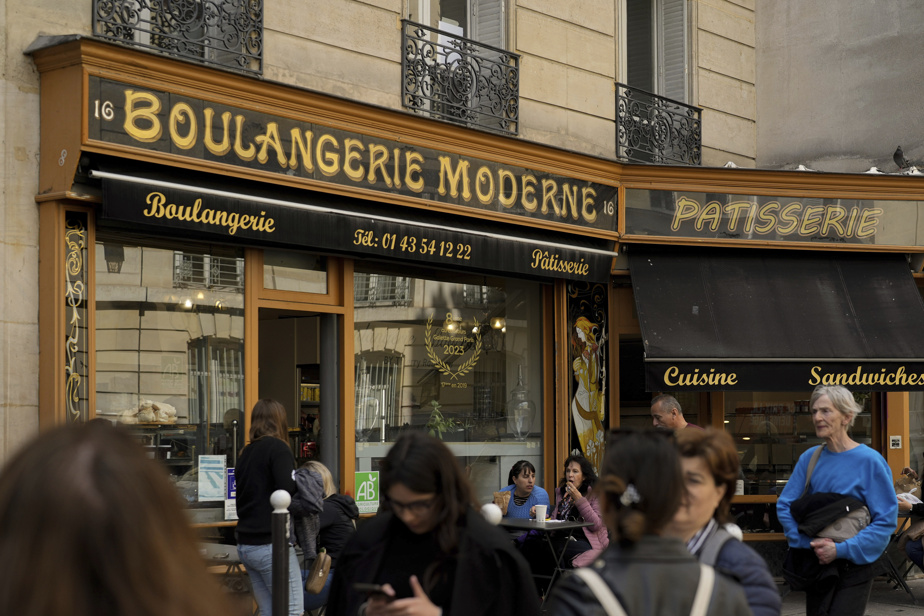(Paris) The huge success of the Netflix series Emily in Paris has transformed a calm and unspoilt square in the French capital into a tourist attraction.
In the historic Latin Quarter and just steps away from the magnificent domed Pantheon, nestled so deeply it could easily be missed, is the Place de l’Estrapade. For diehard fans of the series wearing berets, this part of the neighborhood has become a landmark in its own right.
That’s because it’s where the fictional character of Emily Cooper, a twentysomething American played by Lily Collin, lives, dines, and eats pastries from her local bakery.
This new attraction may be disturbing to the real people who live and work in the area, but the show also sparks a new passion for Paris — and even anti-Emily graffiti has become part of the attraction.
The romantic comedy, whose third season was released in December, traces the adventures and misadventures of Emily in her Parisian career and her love life.

PHOTO THIBAULT CAMUS, ASSOCIATED PRESS
In the historic Latin Quarter and just steps away from the magnificent domed Pantheon, nestled so deeply it could easily be missed, is the Place de l’Estrapade.
On a sunny weekday, the plaza teems with tourists from the United States and far beyond, taking photos, videos, and selfies.
It’s all there: Emily’s building at 1, place d’Estrapade, where she lives in the same building as her love interest, Gabriel. The restaurant where Gabriel — played by French actor Lucas Bravo — is the chef. And, of course, the bakery she loves.
Dancer Riskya Octaviana, from Jakarta, Indonesia, came straight to Paris after performing in Germany because of her love for the show. After twirling around the square, Emily-style, she said, “Emily is my great friend.”
Elizabeth and Ruben Mercado celebrated their 25e wedding anniversary in Paris and visited Emily’s neighborhood as part of their trip. Elizabeth Mercado said she prepared by watching the show just before they left.
“We tried to practice the little bits of French that we learned on the show,” she said.

PHOTO THIBAULT CAMUS, ASSOCIATED PRESS
The building where Emily’s character lives. “Emily Not Welcome” is even scribbled in red graffiti on part of the facade.
Tourists make a point of stopping and snacking at the Boulangerie Moderne, which is featured in the series. The influx of tourists has increased profits, acknowledges owner Thierry Rabineau.
But the flip side came in online comments. Some people, many of whom were posting anonymously, castigated the quality of his baking. Mr. Rabineau believes the show wrongly gave viewers the impression that he was running a luxury patisserie instead of a standard local bakery selling croissants for 1.30 euro (C$1.94).
“People write comments, saying it’s too expensive, it’s not good. It’s disgusting. This disconcerts me, says Mr. Rabineau. It’s a modern bakery, a small neighborhood bakery. »
He is aware of how lucky he is that the show has arrived. “We are taking advantage of a current situation […] But in two or three years there will be no more tourism and we will have to be here to survive,” he said.

PHOTO STÉPHANIE BRANCHU, NETFLIX VIA ASSOCIATED PRESS
Lily Collins stars in the series Emily in Paris,
Stéphanie Jamin, who lives in the square and meets the crowds of tourists daily, has had to adapt to living in an essential place on the tourist map. She says the people themselves aren’t a nuisance, but the crowds can be overwhelming.
“We have become an ultra-tourist district, whereas it was a small place still a little preserved from tourism”, she explained.
Another resident coming out of Emily’s building says he is allergic to the show. “Emily Not Welcome” is even scribbled in red graffiti on part of the facade.
But the graffiti also attracts admirers, with visitors taking photos of themselves pointing out the derogatory remark. Among them was Abdullah Najarri, an internist from Berlin who describes the series as “entertaining”.
“I got to see a lot of Paris through this show, actually, and the lifestyle and the clichés — partly true, partly fake, so that’s nice,” he said.
